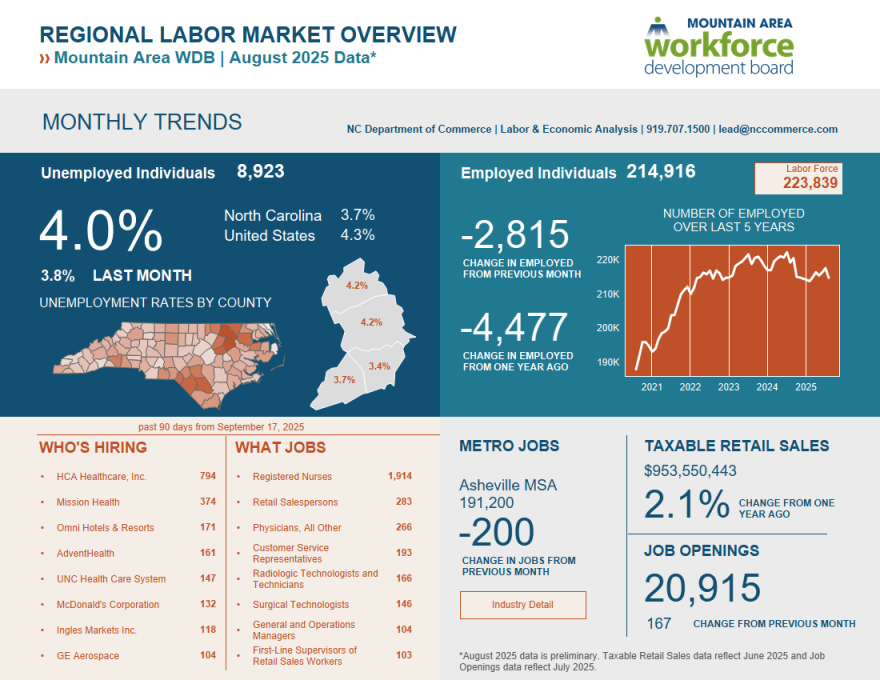There are a few bright spots for Buncombe County in the latest unemployment report.
The data from the North Carolina Department of Commerce shows the county’s jobless rate was 4.2% in August. That’s slightly higher than the statewide average of 4% – but far better than during the immediate aftermath of Hurricane Helene.
As it has for most of the past year, the hospitality sector continues to struggle. A July report by the Department of Commerce shows that 14,321 leisure and hospitality jobs – or 15.6% of the sector – were lost due to the storm.
But some other industries are growing, including education, government and – the big one – health care.
“Partly that’s because those sectors had struggled so much earlier coming out of the pandemic,” Nathan Ramsey, executive director of the Land of Sky Regional Council, told BPR.
Ramsey said the region’s health care industry is seeing high demand for many types of roles, including nurses, physicians and certified nursing assistants.
“The thing in health care, you’ve got a great diversity of the wages. So, some of the highest-paying jobs in our region are in health care. But also, some of the lowest-paying jobs in our region are health care,” he said.
According to the Bureau of Labor Statistics, the mean hourly wage for the “health care practitioner and technical” job category in Asheville is $52.30, while the mean hourly wage for “health care support” is $19.25.
In August, there were 1,400 more available jobs in the education and health services sector compared with the same point a year earlier, according to the state Department of Commerce data. Meanwhile, there were 2,800 fewer leisure and hospitality jobs.

Some of the employers doing the most hiring include Mission Health and HCA Healthcare. HCA has faced sharp criticism for cutting employees after its 2019 purchase of the formerly nonprofit Mission Health System.
Mission Health spokesperson Nancy Lindell said the health system is currently "going all-out on increasing our recruitment efforts with the goal of 200 hires in 100 days."
The campaign includes "enhanced sign-on and referral bonuses," Lindell said. So far, in the first month of the campaign, 124 offers for employment have been accepted at Mission Hospital, she added.
"In addition to 100 RNs, we're focused on hiring another 100 specialty techs including Imaging, Pharmacy, PT, OT, RT, Phlebotomy, EVS, and more," Lindell said in a statement. "Our dedicated team of recruiters have planned an extensive campaign reaching qualified candidates within and well beyond WNC, which includes on-site and virtual hiring events."
The high demand for health care workers is a national trend, but it’s even more pronounced in Western North Carolina, where the population skews older.
“We’ll never meet the demand for the health care workforce,” Ramsey said. “The aging population, the utilization needs that our society will have, we will probably struggle always to meet the health care need.”
Overall, the region’s economy is doing better than it was, but it still has a long way to go, Ramsey said. He noted that after Helene, Buncombe County’s jobless rate skyrocketed “overnight” from the lowest to the highest in the state. Now, it ranks 62nd-highest out of 100 counties.
“It’s sort of like a tale of two cities in our local economy. On one level, jobs are very plentiful. But, you know, what we always struggle against is we also have one of the most expensive housing markets in the state,” Ramsey said.
Two resources for job-seekers are NCWorks.gov and MountainAreaWorks.org. The North Carolina Department of Commerce releases its county-by-county unemployment figures every month.
Note: This story has been updated to include a statement from a Mission Health spokesperson.





